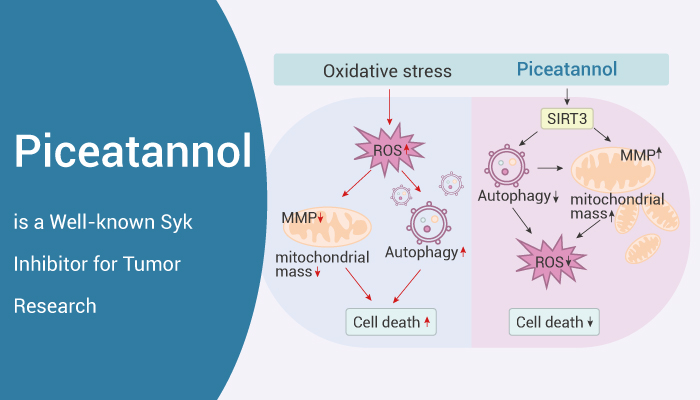Syk (Spleen tyrosine kinase) is a non-receptor protein tyrosine kinase. And it plays a crucial role in signal transduction pathways following immune cell receptor activation. Piceatannol, a known Syk inhibitor, has shown promise in various research areas, including acute lung injury and cancer. This blog post explores the inhibitory effects of piceatannol on Syk activity and its potential therapeutic applications.
Syk and Cellular Signaling: Syk is expressed in hematopoietic and non-hematopoietic cells and mediates signal transduction pathways upon immune cell receptor activation. It associates with different cell surface receptors, contributing to cellular responses such as cytokine production and phagocytosis.

Piceatannol is a Potential Syk Inhibitor for Therapeutic Applications
Piceatannol: Piceatannol is a natural polyphenolic stilbene found in fruits and vegetables. It is a well-known Syk inhibitor with anti-inflammatory and anticancer properties. It has been shown to induce apoptosis and autophagy in certain cancer cell lines.
In vitro experiments demonstrate that piceatannol inhibits the growth of diffuse large B cell lymphomas (DLBCL) cell lines, with IC50 values ranging from 18 μM to >50 μM. This indicates its potential as a therapeutic agent for DLBCL.
In Vivo, piceatannol inhibits pulmonary edema and reduces inflammatory cell infiltration induced by lipopolysaccharide. Additionally, it alleviates myeloperoxidase activity and inhibits the production of inflammatory markers, such as iNOS and COX-2, in lung tissues. Piceatannol treatment also shows promise in attenuating the inflammatory response in acute lung injury through the inhibition of the TLR/NF-κB signaling pathway.
In conclusion, Piceatannol is a Syk inhibitor. And it holds potential for therapeutic applications in diseases involving dysregulated Syk signaling, such as diffuse large B cell lymphomas and acute lung injury. Its ability to inhibit cell growth and modulate inflammatory responses highlights its potential as a valuable therapeutic agent.
References:
[1]. Front Pharmacol. 2020 Jan 22;10:1613.
[2]. J Med Food. 2017 May;20(5):427-438.
[3]. Hematol Oncol. 2011 Sep;29(3):164-6.
[4]. Toxicol In Vitro. 2019 Sep;59:12-25.